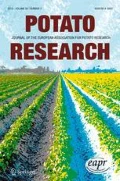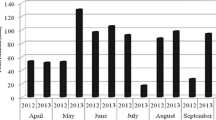Summary
True potato seed of 17 progenies were evaluated during 2002-03 and 2003-04 crop seasons for 12 characters related to seed germination, seedling growth and weed population in nursery beds and tuber yield of transplanted seedlings under non-solarized field conditions. Solarization was found to have beneficial effect on seed germination, seedling growth and yield of transplanted seedlings. Total weeds and major annual weedCornopus didymus were reduced to a great extent due to solarization. However solarization had no effect onCyperus rotundus. Progenies also showed significant differences among themselves for the various characters studied. The progeny x solarization interaction was also significant for all the characters. Yield increase in present study shows that the approach involving raising of seedlings in solarized nursery beds and subsequent transfer of seedlings to non-solarized field would be cost-effective and profitable for raising true seed crop of potato.
Similar content being viewed by others
References
Abdel-Rahim, M.F., M.M. Satour, K.Y. Mickail, S.A. El-Eraki, A. Grinstein, Y. Chen & J. Katan, 1988. Effectiveness of soil solarization in furrow-irrigated Egyptian soils.Plant Disease 72: 143–146.
Al-Kayassi, A.W., S. Ahmed & R. Hussain, 1989. Influence of soil solarization on salt movements and distribution.Plasticulture 84: 47–53.
Davis, J.R., 1991. Soil solarization: yield and quality benefits for potato in a temperate climate short and long-term effects and integrated control.FAO Plant Production and Protection Paper 109: 28–36.
Davis, J.R. & L.H. Sorensen, 1986. Influence of soil solarization at moderate temperatures on potato genotypes with differing resistance toVerticillium dahliae.Phytopathology 70: 1021–1026.
Denner, F.D.N., C.P. Millard & F.C. Wehner, 2000. Effect of soil solarization and mouldboard ploughing on black dot of potato caused byColletotrichum coccodes.Potato Research 43: 195–201.
Egley, G.H., 1983. Weed seed and seedling reduction by soil solarization with transparent polythene sheets.Weed Science 3: 404–408.
Elad, Y., J. Katan & I. Chet, 1980. Physical, biological and chemical control integrated for soil-borne diseases in Potatoes.Phytopathology 70: 418–422.
Gomez, K.A. & A.A. Gomez, 1984. Statistical procedures for agricultural research. John Wiley and Sons, New York, 680 pp.
Gruenzweig, J.M., H.D. Rabinowitch & J. Katan, 1993. Physiological and developmental aspects of increased plant growth in solarized soils.Annals of Applied Biology 122: 579–591.
Katan, J., 1981. Solar heating (solarization) of soil for control of soilborne pest.Annual Review of Phytopathology 17: 211–236.
Katan, J. & J.E. DeVay, 1991. Soil solarization. CRC Press Inc., Boca Raton, USA, 267 pp.
Katan, J., G. Fishier & A. Grinstein, 1983. Short and long-term effects of soil solarization and crop sequences onFusarium wilt and yield of cotton in Israel.Phytopathology 73: 1215–1219.
Katan, J., A. Greenberger, H. Alon & A. Grinstein, 1976. Solar heating by polyethylene mulching for the control of diseases caused by soil borne pathogens.Phytopathology 66: 683–688.
Kotowski, F., 1926. Temperature relations to germination of vegetable seed.Proceedings of American Society of Horticulture 23: 176–184.
Patel, H.R., M.G. Makwana & B.N. Patel, 1995. The control of nematode and weeds by soil solarization in Tobacco nursery: effects of the film thickness and of the covering duration.Plasticulture 107: 21–27.
Rubin, B. & A. Benjamin, 1984. Solar heating of the soil: involvement of environmental factors in the weed control process.Weed Science 32: 138–142.
Simmonds, N.W., 1964. The genetics of seed and tuber dormancy in the cultivated potatoes.Heredity 19: 489–504.
Stapleton, J.J. & J.E. DeVay, 1986. Soil solarization: a non-chemical approach for the management of plant pathogens and pests.Crop Protection 3: 190–198.
Stapleton, J.J., J. Quick & J.E. DeVay, 1985. Soil solarization: effect on soil properties, crop fertilization and plant growth.Soil Biology and Biochemistry 17: 369–375.
Triki, M.A., S. Priou & M. El Mahjoub, 2001. Effect of soil solarization on soil-borne populations ofPhythium aphanidermatus andFusarium solani and on potato crop in Tunisia.Potato Research 44: 271–279.
Author information
Authors and Affiliations
Rights and permissions
About this article
Cite this article
Kumar, R., Sharma, J. Effect of soil solarization on true potato (Solanum tuberosum L.) seed germination, seedling growth, weed population and tuber yield. Potato Res. 48, 15–23 (2005). https://doi.org/10.1007/BF02733678
Accepted:
Issue Date:
DOI: https://doi.org/10.1007/BF02733678




